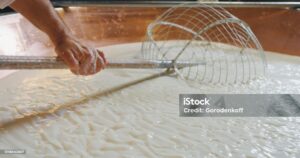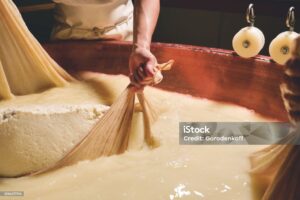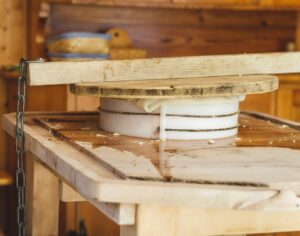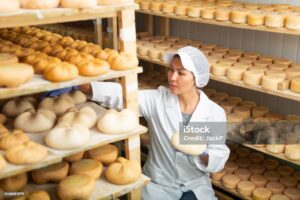What is Cheese?
Cheese is a versatile and beloved food that has been enjoyed by people around the world for centuries. Cheese is made from the curdled and coagulated milk of various animals, such as cows, goats, and sheep. The process of cheese making involves the separation of milk into curds and whey, where the curds are then pressed and aged to develop their unique flavors and textures.
Cheese can be made from raw milk or pasteurized milk. Both have their own end product and their own taste. But cheese make from raw milk must be kept at least 60 days(according to Section 7 CFR 58.439) before entering the market. It helps to kill the harmful bacteria’s present in raw milk.

Essential steps in cheese making:
A variety of procedures go into cheese making, some of which are necessary for almost all types of cheese are discussed below:
1). Milk Pasteurization:
Cheese can be made from raw milk but milk pasteurization is a crucial step in cheese-making that ensures the safety and quality of the final product. The process involves heating the milk to a specific temperature (of about 63oC for 30 minutes OR 72oC for about 15 Seconds) which eliminate harmful bacteria.
The aim of pasteurization is to strike a balance between eliminating bacteria and maintaining the intended characteristics of the milk. Carefully pasteurization effectively destroys harmful microorganisms, such as E.coli and Salmonella, without completely altering the milk’s composition. This allows for the desired flavor, texture, and aroma of the cheese to develop during subsequent stages of the cheese-making process.
2). Clotting of the milk:
This is accomplished by means of enzymes (rennet) or acid (or both).
Rennet, a natural enzyme extracted from the stomach lining of calves, is traditionally used to coagulate milk. When rennet is added to milk, it works by breaking down proteins, specifically casein, which causes the milk to thicken and eventually form curds. The curds, rich in protein and fat, are the foundation of cheese production.The enzymes remove the casein macro peptide ‘hairs’ from κ-casein; the resulting para-casein micelles will then aggregate.
Alternatively, acid can also be used to induce coagulation. By introducing an acid such as lemon juice or vinegar to milk, the acidity level rises, resulting in a chemical reaction that dissolves the colloidal calcium phosphate of the micelles and neutralizes the electric charge on the resultant particles, which will then coagulate. This process, known as acid coagulation, is commonly used in fresh cheese varieties like ricotta and paneer. Acid . Acid is often produced from lactose by lactic acid bacteria. The aggregation causes the formation of a space-filling network, which encloses the milk serum and the fat globules.

3). Removal of the whey:
The gel formed is prone to spontaneous syneresis, i.e., expulsion of whey. Whey expulsion is generally enhanced by cutting the gel into pieces and by stirring the curd–whey mixture that is thus formed. The curd obtained makes up 10 to 30% of the original volume of milk. “The drier the curd, the firmer and the more durable the cheese will become.”
While the liquid portion contains Whey protein which is further used in sports drinks and other purposes.

4). Pressing, Molding & Forming:
As you see in the above figure the solid part which is curd is separated and by pressing it converts into cheese
A good pressing enhances curd fusion and the formation of a closed rind. The duration and pressure applied contribute to the texture and density of your cheese.
For softer cheeses, a lighter pressure is applied for a shorter period of time, allowing for a more delicate texture. Harder cheeses, on the other hand, require a heavier and longer pressing to achieve their characteristic firmness.
The pressure is typically applied using a cheese press, which evenly distributes the weight and ensures consistent shaping and draining of the curds.

5). Brining:
Cheese contains added Na-Cl, generally 1 to 4%. This is typically for ripened cheese when does not apply it referred as fresh cheeses such as quark.
Benefits of Brining of Cheese include:
- The salt affects the durability, and consistency of the cheese.
- The salt also acts as a flavor enhancer, intensifying the taste and making it more enjoyable to consume.
- Brinning of cheese plays a vital role in preserving the cheese. Salt inhibits the growth of unwanted bacteria and molds, extending the shelf life of the cheese and preventing spoilage.
- Salt assists in moisture control during the aging process. As the cheese ages, moisture needs to be carefully managed to prevent excessive drying or the growth of harmful bacteria.
8). Packaging and Storage:
The storage conditions vary widely with the type of cheese involved.
Aging is a crucial step in cheese making, for instance a 60 days holding period at 35oF if the raw milk is used in the first place. Its helps to eliminate harmful pathogen which can cause food borne illness. Cheese age can be vary from several months to several years.
Nowadays, some additional process steps are commonly applied, their main objective being to diminish variation in the conditions occurring during the manufacturing process and in the properties of the cheese.

Variety of cheese:
Some common variety of cheese around the world are given below:
- Cheddar Cheese
- Cottage Cheese
- Swiss /Emmental Cheese
- Blue-Veined Cheese
- Camembert Cheese
- Limburger Cheese
- Processed Cheese
- Mozarella cheese


Some times its a pain in the ass to read what people wrote but this website is rattling user pleasant! .
Heya! I just wanted to ask if you ever have any trouble with hackers? My last blog (wordpress) was hacked and I ended up losing many months of hard work due to no back up. Do you have any methods to stop hackers?
I am no longer sure the place you’re getting your info, however great topic. I needs to spend a while learning much more or working out more. Thank you for fantastic info I used to be searching for this information for my mission.